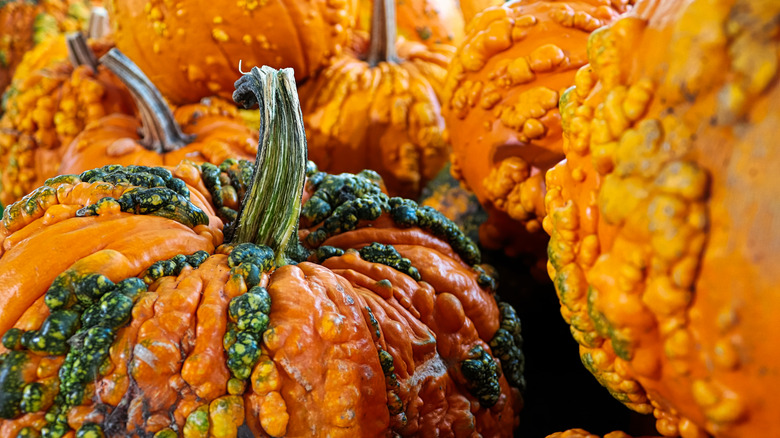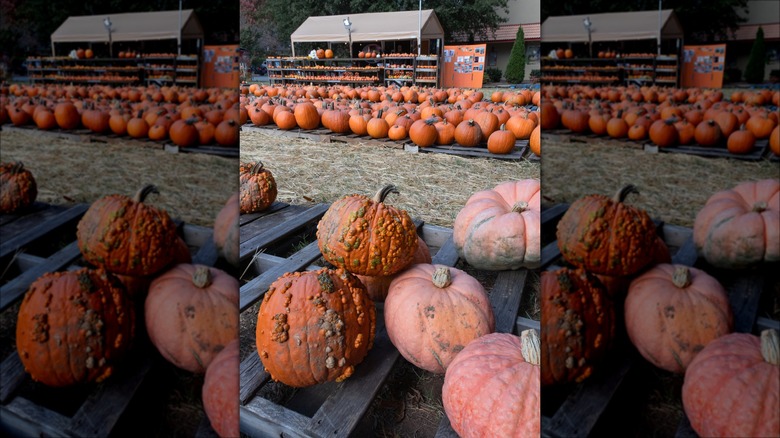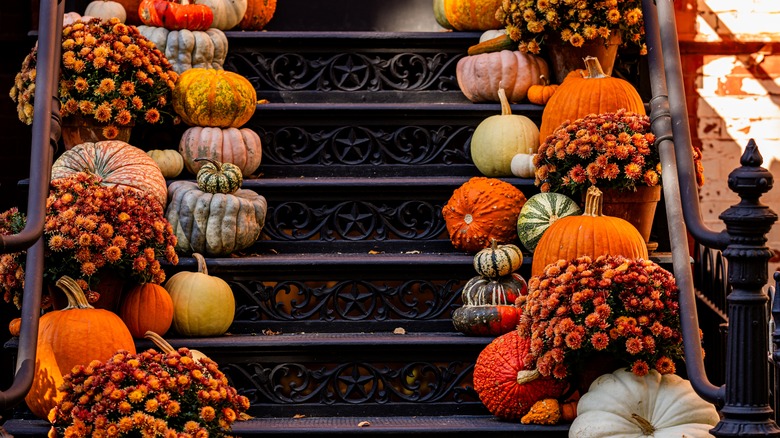What's The Deal With Pumpkin Warts?
We may receive a commission on purchases made from links.
It's probably common knowledge that sugar gives you zits. As it turns out, sugar gives pumpkins zits, too, though usually pumpkin collectors typically call the knotty spots warts instead of the Z-word. And truthfully, this is simplifying things a bit. Some of the knots you find on your Halloween squash also arise from bacteria and viruses, too, which come to think of it, can make for spotty human skin, too. The difference in all of this, of course, is that when it comes time to decorate for Halloween, you might actually want pumpkins with bumpy skin — they're spooky embodied.
There's actually a botanical name for pumpkin warts. It's corking, and the phenomenon really does arise when the squash's sugar content gets too high for the squash to contain, in a manner of speaking. Once that happens, sugar erupts through the skin of the squash, forming pumpkin warts. However, unlike the blemishes that send teens to see a dermatologist, the skin eruptions on the pumpkins are there on purpose, or better said, have been intentionally put there by selective breeding, thanks to Siegers Seed Co., out of Holland, Michigan. The company's warty pumpkins count among the most unique pumpkin varieties on the market.
Pumpkin warts: genetic or viral?
Called Super Freak pumpkins, the Siegers Seed Co. squash variety requires 10 generations of breeding and cross-breeding to develop the desired effect. A pumpkin's ability to cross-breed arises from a particular characteristic of the Cucurbitaceae – squash and gourd — family. Fruits in this botanical family produce male and female flowers, which allows them to co-mingle with other cucurbits to create an assortment of colors and textures. The warty Super Freak pumpkins are basically botany experiments, and over the last several years, the knot-infested pumpkins have become a staple of Halloween porch decor from sea to shining sea.
Although Siegers Seed Co. has produced a number of different bumpy pumpkins, including the Knuckle Head, Gargoyle, and Goosebumps pumpkins, pathogens like the mosaic virus have a talent for making a pretty lumpy pumpkin, too. In mosaic's case, the virus makes its way onto pumpkins via aphids and their pumpkin-munching mouths.
At first glance, the genetically-warted pumpkins and the virus-caused warted pumpkins might appear similar. The giveaway is how the bumps are positioned on the pumpkin in relation to the skin. Genetically-created bumps ride on top of the skin, looking a bit like barnacles on the skin of a whale. Virus-induced bumps look like the lumps are trying to break through the skin like the baby alien in the flick of the same name.
Other things to keep in mind
If you're growing your own pumpkins from seeds, (as opposed to buying them from a farmers market), you'll start to see the beginnings of mosaic disease during the summer. Infected pumpkins develop yellow leaves that you can see from quite a distance away. The yellow leaves are the first clue that something's amiss.
If left unchecked in the garden, squashes infected with the mosaic virus can damage the skin of the fruit so much that other pathogens find a way in. If this invasion happens on a grand scale, the whole crop rots. However, some pumpkins, thick-skinned ones, seem to be more immune to the effects of the bugs and the virus than their thinner-skinned counterparts.
Surprisingly, both kinds of pumpkins can be consumed, though you may not want to eat the mosaic pumpkins, if for no other reason than it seems a bit gross. The fruit may not be of the same quality as other unaffected pumpkins. Aside from that, most pumpkins that are used for jack-o'-lanterns aren't the most ideal for making pumpkin pie.
In light of that, it's probably best just to stick with the pumpkins that were purposely created to be carved. Jack-o'-lanterns made from those pumpkins fit the theme of Spooky Day better, anyway.


